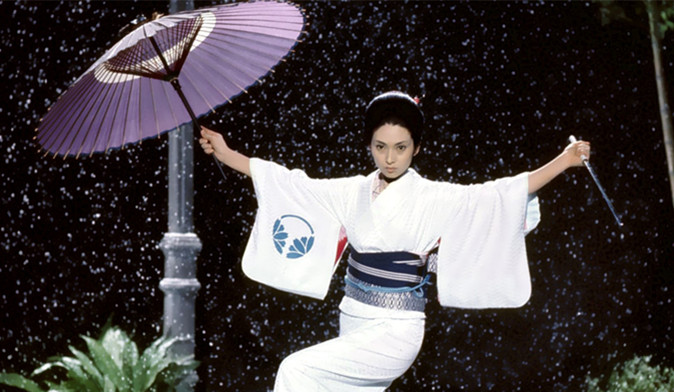
The 1970s brought a stop to the continuing progress of Japanese cinema that occurred during the two previous decades, both in terms of quality and quantity. The main reason was the spread of television that brought a shocking decrease to the audience attending cinemas, from 1.2 billion in 1960 to 0.2 billion in 1980.
Major studios found new ways to cope with this new situation, turning to bigger budget films, sexual or violent content, and “idols”, popular individuals that would bring in audiences, despite their abilities as actors.
On the other hand, the New Wave continued in this decade too, and the turn to exploitation themes brought the rise of pinku cinema. Despite the small budget and the permeating sex and violence, the trend allowed a number of filmmakers to make their first steps in the field, as it allowed significant creative freedom. Among the most notable are Koji Wakamatsu, Teruo Ishii, and Toshiya Fujita.
Furthermore, Nagisa Oshima directed “In the Realm of the Senses” that shocked the world, and Mushi Productions produced “Belladonna of Sadness”, one of the first adult-oriented anime.
In 1978, the Japanese Academy presented its first awards.
These are the 20 best productions of the decade. I have made an effort to place the titles in order of quality, but due to the number of masterpieces included, the order could easily be different. “Dersu Uzala” is a Russian film as much as it is Japanese, but I felt that it could not be missing from this list.
20. Hanzo the Razor (Kenji Misumi, 1972, 1973, 1974)

Definitely the sleaziest entry on this list, the “Hanzo the Razor” trilogy stars Shintaro Katsu of Zatoichi fame, who also produced the trilogy through his own production company. The story is based on the manga “Goyokiba” by Kazuo Koike, and features an incorruptible policeman in feudal Japan who uses unusual methods.
The films are an intermixture of crudeness, gore, and slapstick comedy. Hanzo interrogates women by raping them, using his immense part, which he trains in gruesome rituals. Additionally, the films feature thieves, corrupt officials, bridge sword fights, bondage, and the inevitable fountains of blood.
However, beyond the aforementioned, Masumura directs a series of parodies of the samurai genre, using politically incorrect humor and images regularly found in absurd manga instead of the silver screen. Shintaro Katsu is marvelous as usual in the role of the absolute anti-hero.
19. Female Prisoner 701 (Shunya Ito, Yasuharu Hasebe, 1972, 1973)
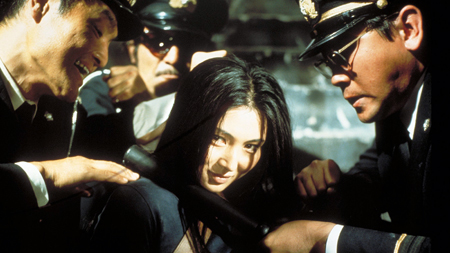
Based on the homonymous manga by Toru Shinohara, the “Sasori” franchise is one of the most influential entries in the exploitation genre and particularly the “women in prison” subcategory.
The four initial films tell the story of Nami Matsushima, a woman who is framed by her boyfriend and ends up in prison, only to transform into a deadly individual named Matsu the Scorpion. The script follows her adventures both inside and outside the prison.
Shunya Ito presents one of his utmost artistic works, using cinematic techniques rarely appearing in the genre. For example, the script progresses as in a comic strip, a tactic chiefly evident in Nami’s persona, where Meiko Kaji acts as if she is a character out of a comic book.
Kaji acts her part in her usual, distinguished approach. She scarcely talks and spends the majority of her scenes either as a victim of violence and humiliation, or as a sex object.
Yasuharu Hasebe, who directed the last part, “701 Grudge Song”, continued in the same fashion as his predecessor, although his film is on a lower level than the ones before, in cinematic terms. The exploitation notions, however, remained at the same level.
The franchise established Meiko Kaji as the cult “goddess” of the 70s.
18. Sex and Fury (Norifumi Suzuki, 1973)
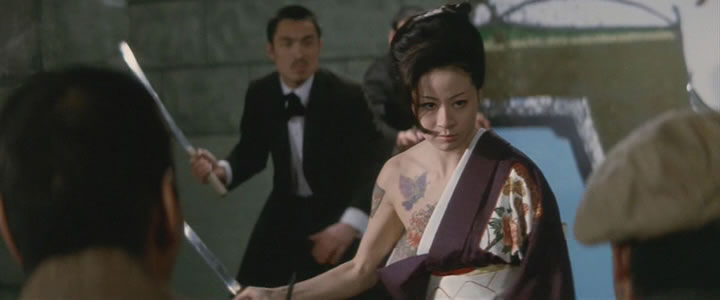
During the Meiji Era in Tokyo, Ocho witnesses her father’s death as a child, a spectacle that stigmatizes her to the point that revenge becomes eventually her sole purpose. Twenty years after the incident, Ocho has become an adept gambler, thief, and swordmaster, abilities she is intent on using to exact revenge. However, the Yakuza is after her, and a friend’s dying request and a meeting with a foreign spy complicate her situation even more.
Reiko Ike, who plays Ocho, in one of her best roles, became a notorious persona in the Japanese film industry of the 70s with this film, particularly due to a scene where she fights naked in the snow slaughtering samurai and ending up covered in the blood of her victims. She was considered an equal of Meiko Kaji in the category, up to the point when she was arrested for drugs and gambling, in a tragic irony that ended her career of portraying similarly acting women.
Norifumi Suzuki made a name for himself during the 70s, the golden era of the Japanese exploitation film. However, he distinguished himself from the mass of similar filmmakers due to his film’s superior cinematography, which included the artful depiction of any kind of torture and violent acts, and for his tendency to include philosophical themes and symbolism in a genre that was utterly superficial.
Aside from the above, the most distinguished characteristics of exploitation films are present, even including girl-on-girl action and a surreal scene with some nuns wielding knives on a train.
Reiko Ike is impressive as Ocho, at least equal with her “rival” in the female killer genre, Meiko Kaji.
17. Ecstasy of the Angels (Koji Wakamatsu, 1972)
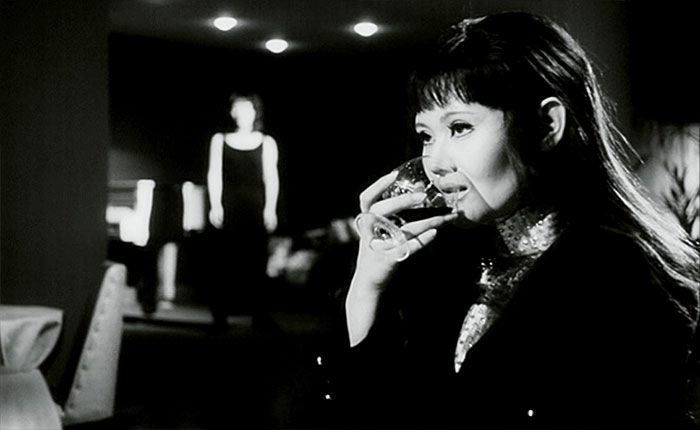
The script revolves around a cell of a revolutionary group, whose leader’s alias is “October” and its members are named after the days of the week. During an infiltration mission in a US military warehouse, several members are killed and October is permanently blinded; however, they manage to steal a number of bombs.
Nevertheless, the leaders of the organization deem October unfit to continue the struggle and subsequently send the head of another cell to retrieve the bombs from the apartment where the remaining members of the group are hiding. Feeling betrayed and isolated, October and his soldiers proceed to take matters into their own hands, and what follows is an alternation between sex, violence, and scenes in a cabaret.
Wakamatsu uses some fascinating cinematic techniques in this film. Nearly all of it is shot in black and white, yet at times, a handful of color emerges to highlight the scenes that the director wants to draw attention. Furthermore, he used the outmoded 4:3 frame to shoot the film, instead of the widescreen Cinemascope format that the majority of the filmmakers were using at the time.
Koji Wakamatsu’s uniquely cult style, which mixes social and political themes with exploitation and obscure art house aesthetics, found its apogee in this black and white film that deals with human decadence and the failure of the student movement that occurred in Japan during the late 60s and early 70s.
16. Sandakan No. 8 (Kei Kumai, 1974)
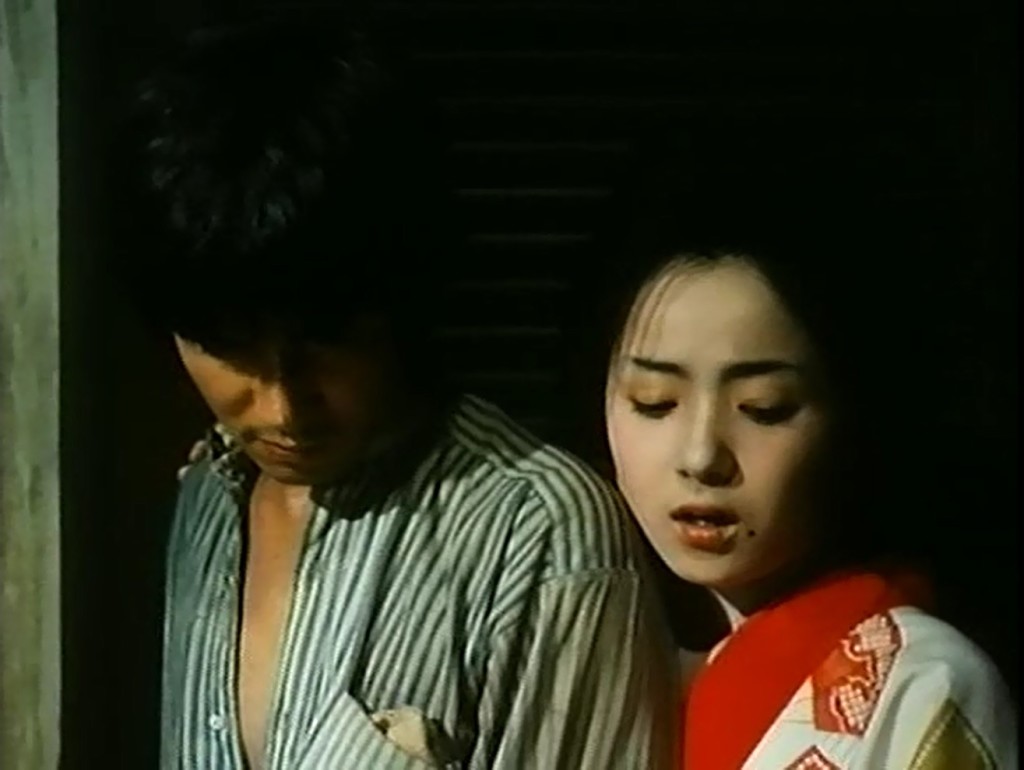
The film is based on the 1972 book “Sandakan Brothel No. 8: An Episode in the History of Lower-Class”, by Yamazaki Tomoko.
The script starts with a young journalist named Keiko Mitani, who researches an article about Japanese women who were forced to work in brothels in Asia in the early 20th century. Mitani meets Osaki, an elderly woman who was forced to work as a prostitute in Malaysia. As the film flashes back to the woman’s story, the two women form a friendship, while examining a black page in the history of their country.
Kei Kumai directs a feminist film, presenting this horrible tendency from the point of view of the victims, while he handles this delicate material with sensitivity.
Yoko Takahashi and Kinuyo Tanaka are wonderful in the roles of young and elder Osaki, with the latter winning awards for her performance from Kinema Junpo, Mainichi, and the Berlin International Film Festival.
15. Throw Away Your Books, Rally in The Streets (Shuji Terayama, 1971)
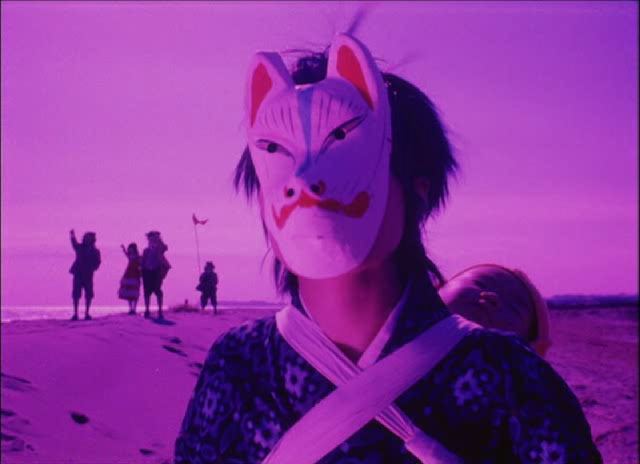
In Shuji Terayama’s first feature film, the protagonist is a nameless young man with a highly dysfunctional family. His grandmother is a shoplifter and his father, a war criminal, has an intimate relationship with a rabbit, along with the protagonist’s sister.
The young man is determined to achieve something in his life, in contrast to the compromised members of his family. In his efforts, he becomes disillusioned about the world and society.
Terayama shot the film with a number of peculiar and unprecedented (for Japan) techniques, like the opening scene with the protagonist talking directly to the audience.
Furthermore, scenes like the one with the burning of the American flag, and the discussion about sports ball size, give the film an anarchic visage, while presenting a metaphor for Japan’s descent into materialism.